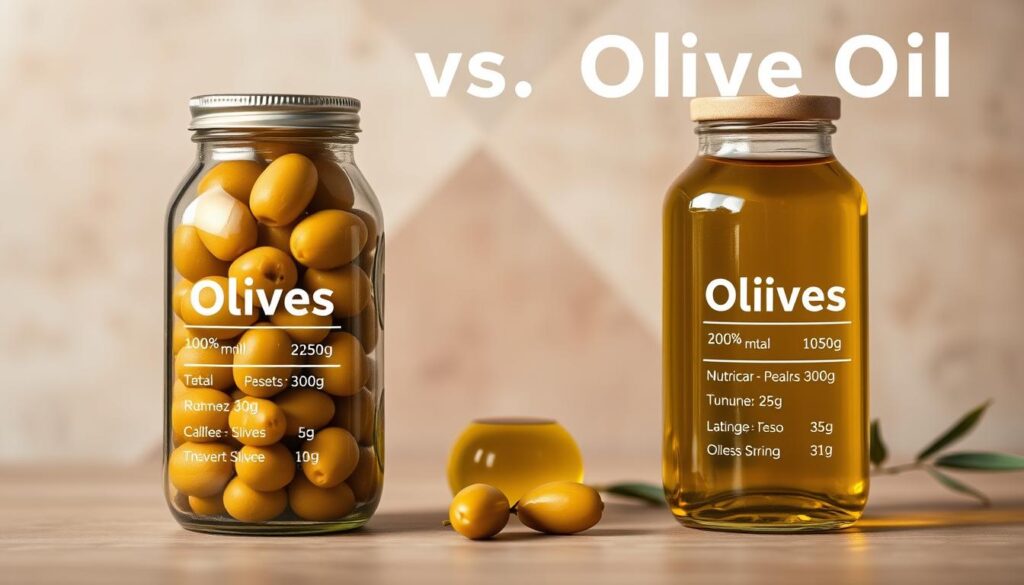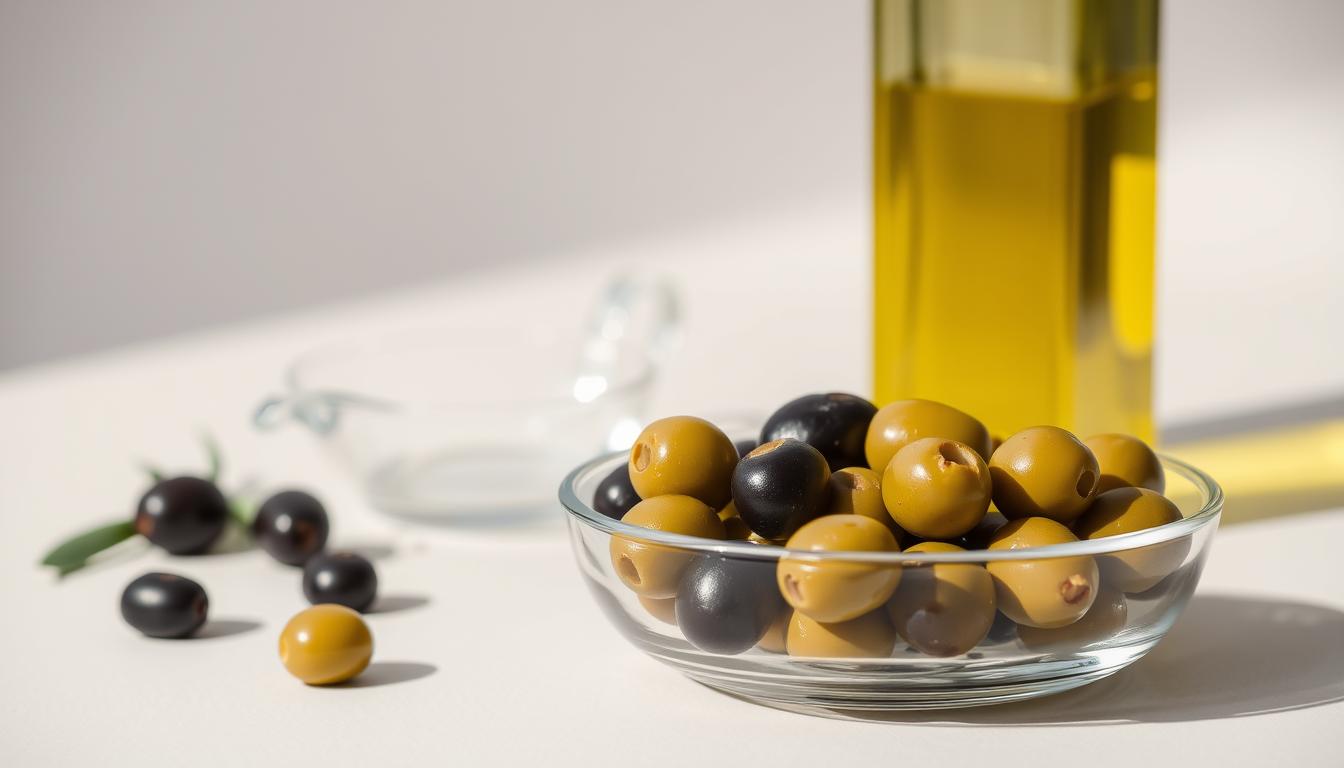Olives vs. Olive Oil: Which One Is Better for Your Health? Are olives good for you ?
Every morning, I stand in my kitchen, thinking about the healthiest foods for my diet. Are olives good for you? What health benefits do they offer? The Mediterranean diet, rich in olives and olive oil, is known for its long life benefits.
California grows about 95% of the olives in the United States. These small fruits are packed with nutrients. Eating whole olives or using olive oil on your salad can change your health for the better.
Knowing the difference between olives and olive oil is more than just about taste. It’s about making choices that can improve your health. These Mediterranean foods are good for your heart and help with weight management.
Table of Contents
Understanding Olives and Olive Oil Origins
Olives have a long history in Mediterranean cultures. They are more than just a fruit. For thousands of years, they’ve been important in nutrition and cooking.

Olives have been grown for millennia in certain regions. Ancient people saw their value and learned to make them tasty. They turned bitter olives into tasty treats full of antioxidants.
Historical Background of Olive Cultivation
Olive trees were first grown around 6,000 years ago. Places like Greece, Syria, and Israel were leaders in olive farming. They developed special ways to grow olives.
- First documented olive cultivation in Crete around 3500 BCE
- Spread across Mediterranean regions through trade routes
- Became a symbol of peace and prosperity in ancient cultures
Traditional Processing Methods
Old ways of making olives were an art. Farmers used patience and skill to make them taste good. They used brining and fermentation to make them tasty and keep their nutrients.
Modern Production Techniques
Today, making olives is different but still careful. New methods keep the quality high. They make sure olives stay nutritious during processing.
- Mechanical harvesting techniques
- Controlled fermentation processes
- Advanced preservation methods
Now, olives are loved worldwide. They connect old traditions with new science. They offer great health benefits because of their antioxidants.
Nutritional Comparison: Olives vs. Olive Oil

Exploring the olive diet shows us the nutritional differences between olives and olive oil. Both come from olives, but they have different nutritional profiles.
Olives are full of healthy fats. A serving of 10 medium olives has about 40 calories. In contrast, a tablespoon of olive oil has 119 calories. The main difference is in fat and fiber content.
| Nutrient | Olives (10 medium) | Olive Oil (1 tbsp) |
|---|---|---|
| Calories | 40 | 119 |
| Total Fat | 4g | 13.5g |
| Fiber | 1g | 0g |
The nutritional breakdown shows key differences:
- Olives have about 20% fat, while olive oil is almost 100% fat
- Whole olives give you extra fiber
- Olive oil is a rich source of monounsaturated fats
Extra virgin olive oil is very nutritious. It has:
- 73% monounsaturated fat (MUFA)
- 13% Daily Value of vitamin E per tablespoon
- 7% Daily Value of vitamin K per tablespoon
Choosing between olives and olive oil depends on your nutritional goals. Olives offer more complex nutrition. Olive oil, on the other hand, is a concentrated source of healthy fats.
Are Olives Good for You? The Health Benefits and Risks
Olives are more than just a tasty snack. They are packed with nutrients that can boost your health. Their high fiber and anti-inflammatory properties make them a great choice for your well-being.
Antioxidant Powerhouse
Olives are full of antioxidants that protect your body. Vitamin E and polyphenols fight off free radicals. This can lower the risk of chronic diseases and keep your cells healthy.
- Contains hydroxytyrosol and oleanolic acid
- Helps reduce inflammation at the cellular level
- Supports overall immune system function
Cardiovascular Support
Olives are good for your heart. They have about 70% mono-unsaturated fatty acids, which help keep cholesterol levels healthy. Their fiber is also key for heart health.
| Nutrient | Amount per Tablespoon |
|---|---|
| Calories | 18 Kcal |
| Fat | 1.8g |
| Fiber | 0.6g |
| Potassium | 15mg |
Weight Management Considerations
Olives can help with weight management. They have unsaturated fats and fiber, which can help you feel full. One tablespoon of olives contains just 18 calories, making them a good choice for those watching their weight.
- Low-calorie snack option
- Helps control hunger
- Provides essential nutrients
While olives are healthy, watch their sodium content. Processed olives can have a lot of salt. The CDC suggests adults eat less than 2,300 milligrams of sodium daily.
The Truth About Olive Oil’s Health Impact
Olive oil is a nutritional powerhouse with amazing health benefits. The healthy fats in olives make it a key part of heart-healthy diets around the world. Extra virgin olive oil is the most potent form, full of essential nutrients and antioxidants.
Olive oil’s health benefits go beyond basic nutrition. Research shows it can protect against several chronic diseases:
- Cardiovascular disease prevention
- Reduced risk of type 2 diabetes
- Potential cancer-fighting properties
- Cognitive function support
The monounsaturated fats in olive oil are key to overall wellness. About 74% of olive oil’s fat composition is oleic acid. This special fat reduces inflammation and supports heart health.
Nutrition experts say to consume olive oil in moderation. It’s calorie-dense, with about 120 calories in one tablespoon. So, it’s important to eat it wisely to enjoy its benefits without too many calories.
When picking olive oil, choose extra virgin varieties. These are processed less and keep more of the beneficial compounds. The quality affects the health benefits you get.
Different Types of Olives and Their Benefits
Olives come in many varieties, each with its own nutritional benefits. Knowing the differences can help you choose the best olives for your health.
The world of olives is full of flavors and antioxidants. Each type adds something unique to your meals, from subtle tastes to bold flavors.
Green Olives: Unripe Nutritional Powerhouses
Green olives are picked before they’re fully ripe. This makes them special in terms of nutrition. Here’s what makes them stand out:
- Picked in September and October
- Higher polyphenol content
- Firmer texture
- Slightly bitter taste
Black Olives: Mature and Mellow
Black olives turn dark when they’re fully ripe. They have a softer texture and a milder taste. Here’s what you can expect:
- Harvested in November and December
- Higher oil content
- Softer texture
- Milder flavor profile
Mediterranean Olive Varieties
The Mediterranean is home to some of the world’s best olives. These varieties are known for their unique qualities:
| Olive Variety | Origin | Key Characteristics |
|---|---|---|
| Kalamata | Greece | Rich, fruity flavor with high antioxidant content |
| Gordal | Spain | Large size, firm texture, meaty richness |
| Mission | California | Mild, grassy flavor with versatile uses |
When picking olives, think about their nutritional benefits. Each type has distinct health advantages that can boost your well-being.
Olive Oil Grades and Quality Factors
Learning about olive oil grades helps you choose better for your health. Not all olive oils are the same. Their quality changes a lot depending on the type.
Extra virgin olive oil is the top pick for health and antioxidants. Here’s a quick look at olive oil grades:
- Extra Virgin Olive Oil: The highest quality with less than 0.8% acidity
- Virgin Olive Oil: Slightly higher acidity up to 2%
- Refined Olive Oil: Processed to remove flavor imperfections
- Pomace Olive Oil: Lowest grade, extracted using solvents
What makes olive oil good for health includes:
- Polyphenol content
- Acidity levels
- Production method
- Storage conditions
Consumer Reports shared interesting facts about olive oil quality:
| Quality Rating | Number of Oils | Price Range |
|---|---|---|
| 4/5 Quality | 4 oils | Avg. $1.76 per ounce |
| 3/5 Quality | 10 oils | Varies |
| 2/5 Quality | 12 oils | 27-92 cents per ounce |
When picking olive oil, choose cold-pressed, organic ones. Look for PDO or PGI labels. This ensures you get the best health benefits and quality.
Sodium Content and Cardiovascular Health
It’s important to know how much sodium is in olives if you’re watching your heart health. Olives are good for you in many ways, but their sodium content is something to think about.
Salt Levels in Processed Olives
Processed olives have more sodium because of how they’re made. Different types of olives have different amounts of salt:
- Black olives have about 50% less sodium than green olives
- Kalamata olives have 53% of the Daily Value (DV) for sodium in just 5 olives
- Rinsing olives before eating can lower sodium intake
Impact on Blood Pressure
Too much sodium can raise blood pressure risks. But, olives also have many health benefits. About 74% of olive fat is good monounsaturated fatty acids, which can help balance out the sodium.
| Olive Type | Sodium Content | Health Considerations |
|---|---|---|
| Green Olives | Higher sodium | Need to watch portion sizes |
| Black Olives | Lower sodium | Good for heart health |
| Kalamata Olives | Moderate sodium | Full of good compounds |
To enjoy olives while watching sodium, eat them in small amounts. Choose low-salt types. The Mediterranean diet shows how to eat olives in a way that’s good for your heart.
Best Ways to Include Olives and Olive Oil in Your Diet
Adding olives and olive oil to your diet is tasty and healthy. They are packed with nutrients, making them great for many meals and snacks.
Find fun ways to add olives and olive oil to your daily meals:
- Snack on 5-10 olives as a quick, nutrient-dense treat
- Sprinkle chopped olives on salads for extra flavor
- Use olive oil as a base for homemade salad dressings
- Drizzle olive oil over roasted vegetables
- Add olives to pizza, pasta, and Mediterranean-inspired dishes
When planning your olive diet https://www.healthline.com/nutrition/foods/olives, remember to control portions. Aim for 15-20 grams (about five olives) to get the most health benefits without too many calories.
| Olive Type | Calories per Serving | Fat Content |
|---|---|---|
| Black Olives | 36 calories | 2g monounsaturated fat |
| Green Olives | 49 calories | 4g monounsaturated fat |
The Mediterranean diet is a great example of how olives and olive oil can boost health. It may help with weight management, leading to weight loss of 1-4.5 pounds.
It’s all about balance and variety. Try different olive types and cooking methods to keep your meals interesting and healthy.
Potential Risks and Considerations
Olives are good for you, but knowing the risks is key. Eating olives and olive oil has some health considerations. These can affect your overall well-being.
When looking at olive health benefits, keep these points in mind:
- High sodium content in processed olives
- Potential presence of acrylamide in canned black olives
- Calorie density of olive products
- Possible allergic reactions
Olives have a lot of sodium. One olive has over 100 mg of sodium. This can cause bloating and health problems if eaten too much. Experts say to eat only 5-10 olives a day to prevent digestive issues.
Processed black olives might have acrylamide, which could increase cancer risk. The curing process also lowers the good stuff in olives compared to olive oil. It’s best to pick less processed options.
Thinking about olive oil is also important. Its health benefits are many, but remember:
- Choose authentic, high-quality olive oil
- Watch out for olive oil scams in the market
- Keep an eye on portion sizes because of high calories
People with health issues or special diets should talk to doctors before eating more olives or olive oil.
Olives and Olive Oil in Different Diets
Olives are very versatile in different diets. They offer great health benefits in many eating patterns. This makes them a top choice for those who care about their health.
People who follow the Mediterranean diet know how good olives are. They have about 11-15 percent fat, which is very nutritious. This diet focuses on using olives wisely in meals.
- Mediterranean Diet: Primary showcase of olive benefits
- Keto Diet: Low-carb friendly olive options
- Plant-Based Diets: Excellent source of healthy fats
- Whole Food Nutrition Plans: Natural nutrient delivery
For those on low-carb or ketogenic diets, olives are a great snack. They have only 59 calories for 10 black olives. Plus, they are full of healthy fats, helping keep your diet balanced.
| Diet Type | Olive Inclusion Strategy | Nutritional Benefit |
|---|---|---|
| Mediterranean | Primary ingredient | Rich in monounsaturated fats |
| Keto | Snack and fat source | Low carbohydrate content |
| Plant-Based | Protein and fat supplement | High in antioxidants |
Those on plant-based diets can use olives as a great source of healthy fats in olives. They are also packed with antioxidants like oleuropein and hydroxytyrosol. These help keep you healthy in many diets.
Conclusion
Exploring olives shows they are a nutritional powerhouse. They are full of vitamins and minerals, making them more than just a snack. Olives also have anti-inflammatory properties, offering health benefits with just a few.
Knowing what’s in olives is important. One serving of 10 large olives has 50-80 calories. They are also rich in healthy fats, which can help with cholesterol. Plus, they have vitamins and minerals that support your health.
Green and black olives have different benefits. Green ones have vitamin E, while black ones have calcium and iron. Adding olives to your diet can be a smart move.
But remember, olives should be eaten in moderation. They have antioxidants like oleuropein that protect your body. Each type of olive, like Kalamata, green, or black, has its own health benefits.
It’s all about balance. Olives are high in sodium and calories. Choose low-sodium options and eat them as part of a balanced diet. By doing this, you can enjoy the health benefits of olives.https://naturalnicehealth.com/healthy-salad-recipes/
FAQ
Are olives good for you?
Yes, olives are full of healthy fats, antioxidants, and nutrients. They help your heart, reduce inflammation, and give you important vitamins and minerals. But, watch out for their sodium, mainly in processed ones.
What are the main health benefits of olives?
Olives are great for your heart, fight inflammation, and might help with weight. They’re rich in healthy fats, have antioxidants like oleuropein, and can improve your cholesterol and reduce stress.
How do green olives differ from black olives nutritionally?
Green and black olives differ in taste and nutrients. Green olives are picked earlier, taste bitter, and are firmer. Black olives are riper, softer, and have different antioxidants. Both are healthy, but nutrients vary slightly.
Is olive oil healthier than whole olives?
Both offer unique benefits. Whole olives give you more fiber and nutrients. Olive oil focuses on healthy fats and antioxidants. Extra virgin olive oil is great, but whole olives offer more fiber and nutrients.
How much sodium do olives contain?
Olives have a lot of sodium from brining. A serving of 5-6 olives has 100-200 mg of sodium. To cut down on salt, rinse them or pick low-sodium ones.
Can olives help with weight management?
Yes, olives can help with weight. They’re high in fiber and healthy fats that make you feel full. But, they’re calorie-dense, so eat them in moderation.
What are the best ways to incorporate olives into my diet?
Enjoy olives in many ways: as a snack, in salads, on pizzas, or in Mediterranean dishes. Chop them for salads, use as toppings, or eat them whole. Olive oil is great for cooking, dressing salads, or as a finishing touch.
Are there any risks associated with eating olives?
While olives are healthy, there are risks. High sodium can affect blood pressure, and some might be allergic. Processed olives may have preservatives. Choose high-quality, minimally processed ones and eat them in moderation.

